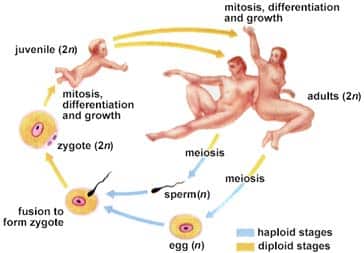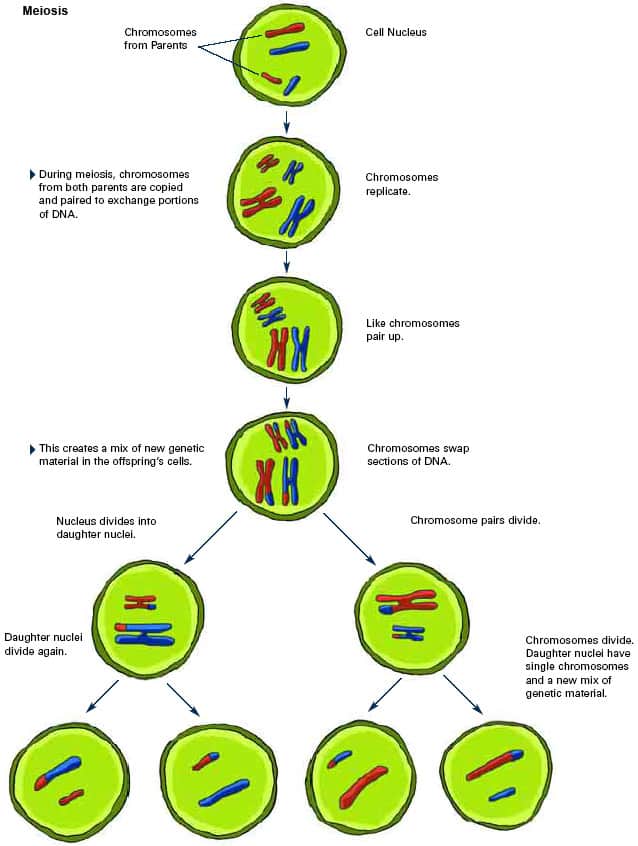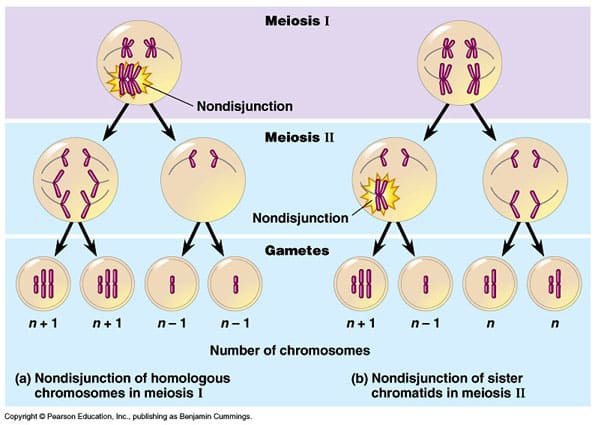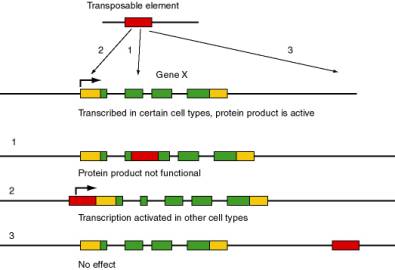- Sexual reproduction: production of offspring; union of male and female gametes
- Gametes: eggs and sperms cells in animals
- Sexual reproduction depends on
- Meiosis; specialized process of cell division; recombines DNA sequences, produces cells with half the number of chromosomes in somatic cells. (chromosome= reduction)
- Fertilization: nuclei of egg/ sperm fuse; producing zygote (# chromosomes typical in species= restored)
- Without halving #chromosome with meiosis; #chromosomes passed onto offspring would double ever success generation
Meiosis/ Fertilization MIX genetic material
Meiosis
NOT intended to contribute to the body of the organism that make them
- Reducing # of chromosomes
- Mixes genetic material (through crossing-over)
Fertilization
- Restores # of chromosomes
Diploid: stage with TWO basic sets of chromosomes
- Haploid: stage with ONE basic set of chromosome
- In Animals: haploid phase is seen after meiosis -> gametes -> fertilization, zygote= diploid
- In Planets: Half/ Half- Meiosis -> Spore -> Gametophyte (n) -> Gametes -> fertilization zygote= diploid
- In Fungi: Mainly haploid -> Meiosis -> Spore -> Gametophyte (n) -> Gametes -> fertilization zygote= diploid
Homologous pair: have same genes in same order BUT different versions of genes expressed; make up diploid cell constitute
- Paternal Chromosome: derived from the male parent
- Maternal Chromosome: derived from the female parent
Alleles: different versions of genes found on homologous chromosome pairs
Meiosis: reduces diploid (2n) number of chromosomes to haploid (n)
Meiocytes: cells destined to divide by meiosis, replicated DNA and enter meiosis
Meiosis I: homologous chromosomes find their partners and pair lengthwise, gene for gene= synapsis
Meiocyte (4n) -> Meiosis I (2n) -> Meiosis II (n) Product: 4 cells, all with haploid number of chromosomes; new collection of alleles
Interkinesis- separates two meiotic division; NO DNA REPLICATION!
Prophase I
- Chromosomes condense; line up side by side; called pairing & synapsis (tetrads: two set of dipoid homologous pairs, pair up; 4 chromatid total) Recombination occurs; physical exchange of alleles to make new combinations
- Prometaphase & Anaphase I: spindle microtubules align tetrads on equatorial plane (metaphase plate)
- Telophase & Interkinesis: brief transition
Meiosis II is very similar to mitosis; HOWEVER only happens in reproductive tissue; no immediately preceding S phase; daughter cells not genetically identical.
Nondisjunction: in anaphase I, spindles fail to separate the homologous chromosomes; one pole gets both homologous chromosomes; one side doesn’t; in Meiosis II, one cell will end up having no chromosomes, and one with diploid amount. (polypoid/ anuploid) usually results in death; exception is DOWN SYNDROME!
Sex Chromosomes: female= XX (fully homologous) male= XY (homologous only through a short segment)
Repair during Meiosis. Meiosis accomplishes a sort of DNA “repair” because in meiosis I, when the chromatids are pulled to opposite poles of the cell, any error in the chromosome would be diminished to one out of the two cells. Furthermore, as meiosis II occurs, and the two cells split again, the damaged chromosome would reside in one of the four gametes. This leaves only a 25% chance of this gamete being used in reproduction. Also, a level of natural selection most likely occurs in the sense that a damaged gamete is less likely to survive than an undamaged gamete, thus “repairing” the “damage” between the generations.
FOUR MAJOR SOURCES OF GENETIC VARIABILITY FROM MEIOSIS AND FERTILIZATION
- Genetic Recombination: occurs in prophase I (crossing over/ chiasmata); synaptonemal complex: protein framework supporting chromosomes to exchange segments and make new combinations
- Random segregation of paternal/ maternal chromosomes. Chromosomes in each homologous part randomly segregates to each spindle pole
- Alternative Combinations at Meiosis II. Segregation again of chromosomes during anaphase II; each homologous pair has one recombinant chromatid and one non-recombinant chromatid; could randomly segregate to either spindle end to create new allele combination.
- Random fertilization; which male/ female gamete combine. The fusing of the random male and female gametes increases the genetic diversity by even more. 1/ (2^23)^2. 23 sex chromosomes each; two gametes.
Mobile Elements: particular segments of DNA, can move from one area to another; cut and paste DNA and backbones; but don’t need homology!!!! (jumping genes) moves within genome of a given cell)
Tranposable elements (TEs)
Mechanism of movement/ nonhomologous recombination; Transposition
- TEs leaves it original location and moves to new location
- TEs copies itself, sends new copy to the new location
TEs must have contact with section of DNA they want to integrate into; not free agent (jumping genes= inaccurate)
TEs increase variability; biological mutagens!
Two major bacterial TEs:
- Insertion sequences (IS): simple, small, only carry genes for transposition, transposase: cataylzes recombination of bacterial TE into DNA
- Transposon: inverted repeat sequence (insertion sequences) surrounding the central regions for 1+ genes.
- Many antibiotics carried as transposon!
- Barbara McClintock, first discovered TEs in eukaryotes.
- Retrotransposons: DNA element; transcribes intermediate RNA copy of TE. Reverse transcriptase, uses RNA to make DNA copy; new dna copy inserted into new location.






good diagrams helped me understand cell division more clearly
Hey, thanks for the info!
very good diagrams. helped me pass my higher biology NAB. Extremely impressed. well done! 😀
excellent.